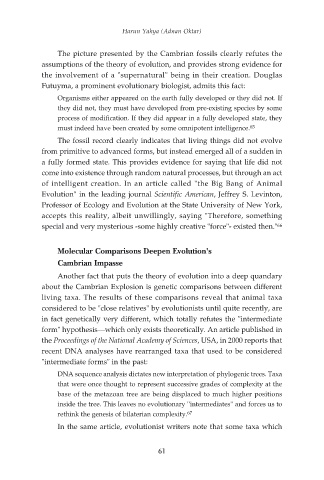Page 63 - Darwinism Refuted
P. 63
Harun Yahya (Adnan Oktar)
The picture presented by the Cambrian fossils clearly refutes the
assumptions of the theory of evolution, and provides strong evidence for
the involvement of a "supernatural" being in their creation. Douglas
Futuyma, a prominent evolutionary biologist, admits this fact:
Organisms either appeared on the earth fully developed or they did not. If
they did not, they must have developed from pre-existing species by some
process of modification. If they did appear in a fully developed state, they
must indeed have been created by some omnipotent intelligence. 65
The fossil record clearly indicates that living things did not evolve
from primitive to advanced forms, but instead emerged all of a sudden in
a fully formed state. This provides evidence for saying that life did not
come into existence through random natural processes, but through an act
of intelligent creation. In an article called "the Big Bang of Animal
Evolution" in the leading journal Scientific American, Jeffrey S. Levinton,
Professor of Ecology and Evolution at the State University of New York,
accepts this reality, albeit unwillingly, saying "Therefore, something
special and very mysterious -some highly creative "force"- existed then." 66
Molecular Comparisons Deepen Evolution's
Cambrian Impasse
Another fact that puts the theory of evolution into a deep quandary
about the Cambrian Explosion is genetic comparisons between different
living taxa. The results of these comparisons reveal that animal taxa
considered to be "close relatives" by evolutionists until quite recently, are
in fact genetically very different, which totally refutes the "intermediate
form" hypothesis—which only exists theoretically. An article published in
the Proceedings of the National Academy of Sciences, USA, in 2000 reports that
recent DNA analyses have rearranged taxa that used to be considered
"intermediate forms" in the past:
DNA sequence analysis dictates new interpretation of phylogenic trees. Taxa
that were once thought to represent successive grades of complexity at the
base of the metazoan tree are being displaced to much higher positions
inside the tree. This leaves no evolutionary ''intermediates'' and forces us to
rethink the genesis of bilaterian complexity. 67
In the same article, evolutionist writers note that some taxa which
61

